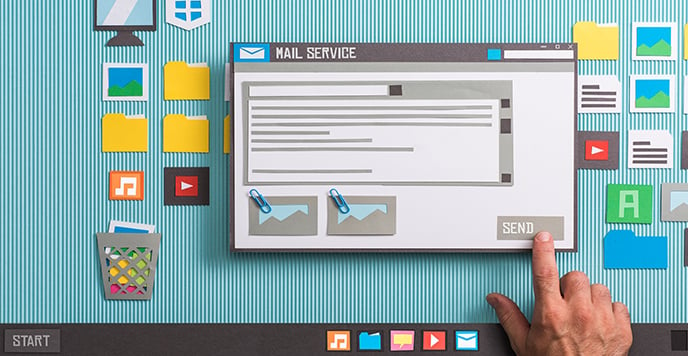Intranet + Email + IM: A Hybrid Model for Office Communication
IM has become a popular communication tool in the workplace, but its purpose is limited. Learn why adopting a hybrid model ensures all your bases are covered.


Thanks to the growing popularity of instant messaging (IM) apps, what started as a simple way to streamline collaboration and reduce emails has turned into app overload. And it’s taking a toll on employee satisfaction and killing productivity.
From Salesforce to time-tracking software, almost every application now offers chat features in some capacity. As a result, conversations are happening across dozens of platforms (up to 28 per employee, according to this study) with no rhyme or reason as to how company information is being stored or shared.
Then there are messaging-centric tools like Slack and Microsoft Teams that promise to keep your company connected using a mix of all-company, department-specific, and project-related channels. Though loved by many, the chaos that ensues as new channels are introduced and old channels pile up is unwieldy to tame, leaving organizations in a worse state than when they started.
One study found that it takes employees an average of eight minutes to get back on track after replying to a chat message. Multiply that by the number of instant messages employees receive in a day and it’s no wonder productivity in today’s digital workplace is suffering.
Throwing out IM is not the solution. In fact, there are still many good uses for quick and sporadic conversations with our coworkers, some of which are outlined in this article: Get the Most out of Internal Messaging: Give it a Home in Your Digital Workplace.
So then, how can we integrate IM into a greater office communication strategy that enables higher levels of productivity and engagement, but still gives employees the flexibility to work how they want? It requires a hybrid approach, with the intranet at the core acting as a consolidation platform and presentation layer into you other applications.
A hybrid model for office communications
The digital workplace is the central destination that provides employees with convenient access to all tools, processes, and information within a company. Every bit of work that happens in your organization happens there, which means information and relevant conversations are recorded and stored together.
Inside your digital workplace, there are three common methods of communication that employees can use to get their work done: the intranet, email, and IM. While each have their own purpose and strengths, they’re all critical components of a modern office communications strategy.
Here’s a simple explanation of how each tool could support this model:
- An intranet centralizes company-wide communications, stores information and knowledge for all employees to access, enables team collaboration, and acts as a culture vehicle that gives employees a sense of purpose and belonging. Your intranet must also tightly integrate with your chat apps and email in order to maintain knowledge and put conversations into context of the work being done.
- IM or chat enables fast, direct conversations with individuals or groups and fosters a rapid flow of actions and ideas between employees. Employees from younger generations grew up in the age of instant communication, so they will naturally gravitate toward this method.
- Email is best suited for external communications or as a way to direct employees to information that is stored on the intranet. While it isn’t realistic to completely phase email out – as a primary communication tool for the last few decades – but it can be used more effectively alongside these other methods.
Employees will choose the tools that make them the most productive. By centralizing all the information in the digital workplace, the hybrid model creates flexibility for employees of different ages, work preferences, and technical know-how.
How to enact a 3-in-1 model
The hybrid model for office communications may not come naturally to employees, especially if they’re accustomed to using only one or two of the methods mentioned above.
That’s why it’s important that employees understand how the model works and why it’s important to follow it.
Here are four ways to make the hybrid model an essential part of your culture:
- Clearly communicate the model. Explain what communication tools are available, and how and why they are expected to use them.
- Educate from day 1. Introduce the hybrid model during company or departmental onboarding so that new hires know what the standards are and how they’ll be enforced.
- Remove barriers to adoption. For example, if you want employees to use the intranet for communicating, collaborating, and storing knowledge, make sure it’s easy for them to do so. Otherwise, they’ll find workarounds using other tools.
- Set expectations for compliance. With corporate security at stake, it’s important for employees to know what tools they should (and shouldn’t) use to store sensitive information.
Reap the rewards
Offering a hybrid of communication tools allows you to cater to every employee’s work preferences. After all, everyone wants to foster a work environment where employees can manifest their own work style and reach their full potential.
With a next-gen intranet solution that integrates with your messaging apps and email, you can create a single digital destination where employees send and receive information with ease. Fewer messages to manage, less confusion about what goes where, and a lot more time for productive work.
Learn more about Igloo’s digital workplace solutions for communication here.





